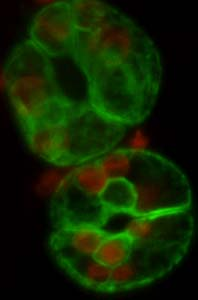Research interests
Research interests
Calcium signalling and ion channel regulation in guard cells
Structure and gating in plant potassium channels
SNARE function and redundancy in plant membrane traffic
Roles for SNAREs in signalling
Why research plant cell biology? Here is one answer!
Plant biomass is inextricably tied to water transpiration: increases in crop production depend fundamentally on increased water use, regardless of improvements in water management or farming practice. On a global scale water use and the physiological consequences of stress, when water becomes limiting, remain among the most important factors that influence vegetative plant growth and yield. To quote the FAO (www.fao.org/english/newsroom/news/2003/15254-en.html) ... "serious water and food security problems in some developing countries and regions need to be urgently addressed, using existing and new technologies.
Agriculture is by far the biggest water user, accounting for some 70% of all water withdrawals" (http://www.unep.org/dewa/assessments/ecosystems/water/vitalwater/management.htm). FAO projects that world food production needs to be increased by around 60% to feed an additional 2 billion people by 2030. Agricultural water use will be a key element for increasing food production, especially in many developing countries, where currently around 800 million people are suffering from chronic hunger. Irrigation agriculture currently produces 40 percent of the food crops on 20 percent of arable land in these areas. Much of the future food production increase will come from irrigated land.
And why focus on stomata?
The primary defense of the plant against water loss and dehydration is to reduce transpiration from the leaves, primarily by closing stomatal pores in the leaf surface. Closing stomatal pores also reduces CO2 entry to the leaf and so affects photosynthesis and vegetative yield. Stomatal regulation has been linked to changes in plant water usage and increased water runoff that is associated with ongoing climate changes [see Gedney, et al. (2006) Nature 439,835]. Clearly, understanding stomatal function and the factors that control it is of huge importance for agriculture, and so for future use of water, arable and irrigated lands.
Here is another good reason.
The guard cells that surround stomatal pores have become a focus of attention in fundamental research as well. The ability of these cells to integrate both environmental and internal signals and their unique situation within the leaf tissue has provided a wealth of experimental access points to signal cascades that regulate plant membrane transport. The past 20 years of research has raised the status of the guard cell to that of an undisputed cell "model", and some of the most exciting findings in eukaryotic cell signalling in recent years have come from work with guard cells, taking advantage of the "stomatal interface" between molecular genetics, biophysics, and cell biology.
(courtesy J. Haseloff, Cambridge)
The Laboratory of Plant Physiology and Biophysics now exploits this wealth of information in many aspects of research, as well as taking advantage of other cell models to explore fundamental issues in cell biology under joint guidance of Prof. Blatt and Dr. Anna Amtmann. Research under Prof. Blatt centres around topics of signalling, ion channels and membrane traffic. These interests complement those of Dr. Amtmanns research group which focus on plant K+ nutrition, K+ transport interactions, regulation and salinity. The Laboratory currently numbers some eighteen research staff, students and visitors, and holds over £1.5M in external research grants and contracts.

